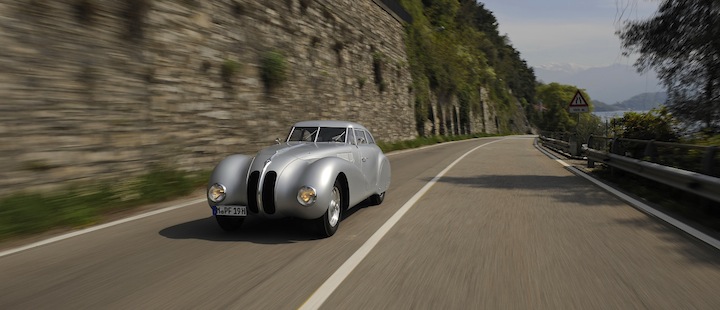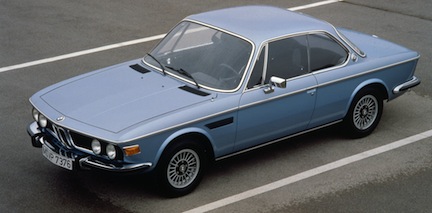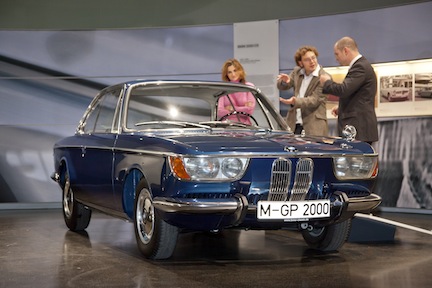BMW lines up three historic cars for rally in Argentina

(November 13, 2013) More than 130 historic sports cars spanning eight decades of automotive history will go head to head for victory in the “1000 Millas Sport” in Argentina. This year’s event will be the 25th edition of South America’s foremost classic car rally. And to help celebrate this landmark occasion, the BMW Group Classic will be sending not only its congratulations but also a trio of exceptional cars embodying the sporting spirit of the BMW brand on a variety of levels.
The BMW 328 Kamm racing saloon (pictured at top) for example, recalls the first major racing success achieved by a BMW car over 70 years ago. And it will be joined on the journey through Patagonia by a BMW 2000 CS and BMW 3.0 CS, which heralded the dawn of a new coupe era for the brand and laid the foundations for BMW’s spectacular success in international touring car racing through the 1970s.
The 1000 Millas Sport is a competition for historic vehicles hosted by the Club de Automoviles Sport (CAS) in Argentina and approved by the FIVA (world federation of historic vehicle clubs). The 25th anniversary edition of the rally — which is run as a regularity time trial — will bring together participants from 14 nations.
They include last year’s winner Juan Tonconogy from Argentina (who won the Mille Miglia in Italy this May) and Frenchman Cyril Despres, a five-times motorcycle winner of the Dakar Rally, which has been co-hosted by Argentina every year since 2009. The entry list of sports cars built between 1918 and 1983 will be split into seven categories to take into account their varying ages.
 The rich variety of cars in the field is one of the great attractions of the 1000 Millas Sport. Another is the route for the event, which allows the drivers to soak up the unique charms of the Patagonian landscape along the way.
The rich variety of cars in the field is one of the great attractions of the 1000 Millas Sport. Another is the route for the event, which allows the drivers to soak up the unique charms of the Patagonian landscape along the way.
Starting from San Carlos de Bariloche, the competitors will set out along a different route on each of the rally’s three days. The first stage along Lake Nahuel Huapi and over the border into Chile is followed by a stretch running parallel to the Andes on Ruta 40 up to the northern village of Junin de los Andes and back.
The final stage takes the cars south and includes a detour to a race circuit. Each of the three stages offers magnificent views over the mountain peaks of the southern Andes and their unspoiled valleys. The spring weather and wonderfully prepared roads provide ideal conditions for the precious classic racing cars.
BMW Group Classic is bringing one of the most spectacular cars in its collection to the 1000 Millas Sport. The BMW 328 Kamm racing saloon is a faithful replica of the racing car built in 1939 using the latest aerodynamics and lightweight design expertise — and which competed in the Mille Miglia a year later.
Developed in close cooperation with streamlined design pioneer Wunibald Kamm, the sports car boasted a still impressive Cd of 0.25. Its space frame (weighing just 30 kg) and aluminum bodywork gave the BMW a curb weight of 760 kg, and the 136 hp six-cylinder in-line engine powered it to a top speed of 230 km/h (143 mph). Accident damage meant the original car was consigned to the scrap heap in the early 1950s, but in 2010 BMW unveiled this replica version, which traces the original design drawings in full. And it has been a regular attraction at international classic car exhibitions and competitions ever since.
 The brace of coupes joining the Kamm saloon in Argentina have also earned their place in the sports car history of the brand. In 1965, just a few years after the arrival of the “Neue Klasse”, BMW unveiled an elegantly sporty two-door model series. The BMW 2000 C and BMW 2000 CS were trumpeted as the “rebirth of the BMW 327” at the time and dazzled the car-loving public with their beguiling combination of sporting ability and luxurious comfort. Over the five years the coupe series was in production, 11, 710 examples were sold.
The brace of coupes joining the Kamm saloon in Argentina have also earned their place in the sports car history of the brand. In 1965, just a few years after the arrival of the “Neue Klasse”, BMW unveiled an elegantly sporty two-door model series. The BMW 2000 C and BMW 2000 CS were trumpeted as the “rebirth of the BMW 327” at the time and dazzled the car-loving public with their beguiling combination of sporting ability and luxurious comfort. Over the five years the coupe series was in production, 11, 710 examples were sold.
The BMW 2000 CS entered in the 1000 Millas Sport 2013 is powered by a 120 hp four-cylinder engine, which accelerates the coupe from 0 to 100 km/h (62 mph) in 11.0 seconds.
Boosted by meticulous further development of the new coupe concept, the two-door completed its journey into the upper echelons of the car market in 1968. And it wasn’t long before it was competing on the race track as well. For the model generations that followed, BMW designers kept faith with the light and intricate-looking roofline flowing smoothly into a low-slung rear.
A longer hood lent an even more sweeping presence to the car’s proportions and created space for a straight-six engine, which developed 170 hp in the BMW 2800 CS. That output figure rises to 180 hp in the BMW 3.0 CS entered for the 1000 Millas Sport 2013. The highlight of the model series – of which more than 30,000 units were sold up to 1975 – was the BMW 3.0 CSL, which produced up to 206 hp.
This lightweight coupe, with its large spoilers and striking rear wing, was designed to provide the basis for a race-specification touring car. And it left an immediate impression on demanding private customers and race-track rivals alike. The BMW 3.0 CSL racked up six European title crowns in seven years, and by finishing top of the manufacturers’ standings in the American IMSA GT race series in 1975, BMW also succeeded in showcasing the sporting potential of the brand in the USA.
